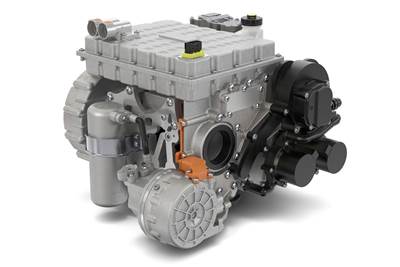How is an EV Battery Made?
Everyone talks about batteries, but how are they produced? Here’s the long and short (circuit) of it.
Share






The Ultium battery for the GMC HUMMER. Earlier this year Ultium Cells—a joint venture between LG Energy Solution and General Motors—announced a $2.6-billion investment in a battery plant in Lansing, Michigan. This is the third massive plant it is building. The others are in Ohio and Tennessee. Photo Credit: Ultium
One of the biggest differences between a vehicle with an internal combustion engine (ICE) and an electric vehicle (EV) is the battery that’s used to store energy for the EV. While the 12-V lead-acid battery in an ICE vehicle starts the vehicle, the 400-V (likely) lithium-ion battery in an EV keeps it going.
Three Steps
Battery production—nowadays performed in a “Gigafactory,” which simply means “big battery plant”—has three primary steps, primarily automated:
- Electrode manufacture
- Cell assembly
- Conditioning
As for the first, there are typically two production lines, one for the anode and the other the cathode. There is a slurry prepared that is coated on both sides of a foil. This is followed by drying in an oven, then calendaring, as the coated foil is run through two heated rollers. Then the foil goes through a slitting operation. The result is several coated coils.
Then cell assembly, which involves cutting the electrodes and putting them in their containers: pouch, prismatic or cylindrical cans. Coils are cut (mechanical or laser) into individual sheets. The sheets are stacked—anode/separator/cathode. There are electrode tabs that are exposed; they are welded to the main terminals. The cell is placed into its container, which is filled with electrolyte, then sealed.
Finally, the assembled cell undergoes charging and testing.
The cells are then assembled into modules, then the modules into a pack. And the pack into the vehicle.
There’s Experience & Equipment
Edurne Arteta, is an associate engineer in the Cell Prototyping research group of the Electrochemical Energy Storage area of , a private non-profit foundation center established by the Basque Government in 2011. The specialization in batteries makes it one of the top reference centers in Europe. Arteta’s experience encompasses things from designing production lines for batteries to assisting automotive OEMs in EV strategies.
So we asked her to provide some insights into EV batteries.
For example, those steps to creating a cell: Any different for other products?
Arteta: “The defined operations represent the process for Li-ion battery manufacturing, which can be found in all sorts of applications. From small cell phones to larger batteries used in EVs or energy storage devices.”
So presumably there is equipment available, right?
“By now, there are many equipment suppliers specialized in battery production machinery. There are suppliers providing fully automated cell assembly lines and electrode manufacturing lines that are adapted to the client’s cell design. Probably, formation, aging and test system setup [i.e., the third step] has the most custom-made equipment.”
In terms of producing cells, what are OEMs looking for?
“For the automotive industry, the is key to get high energy densities in compact cells, hence the latest variations in format and size depending on the car manufacturer.”
Lots of Demand
CIC energiGUNE projects there will be from 35 to 40 gigafactories in Europe by 2030 to meet the automotive demand of an anticipated 1,000 GWh per year.
In the U.S.? There is some catching up to do (in large part because EV demand in Europe is approximately double that of the U.S. at present).
The “National Blueprint for Lithium Ion Batteries: 2021-2030” prepared by the U.S. Federal Consortium for Advanced Batteries, notes that in 2020 the U.S. had battery production capacity for EVs of 59 GWh (only 8% of the global 747 GWh). While the Consortium projects that there would be U.S. capacity of 224 GWh by 2025, it points out: “demand from U.S. annual sales of passenger EVs alone is projected to surpass this anticipated 224 GWh lithium-ion cell manufacturing capability in 2025.”
There’s a lot of work to be done.
Related Content
FANUC Details Robotic Vision, ROBODRILLS and More at IMTS 2024
FANUC’s IMTS 2024 booth includes real-time demonstrations that show the abilities of its equipment, including robots, controllers and machine tools.
Read MoreTrak Machine Tools Lathes Offer Compact, Heavy Duty Performance
IMTS 2024: The Trak TC2 and the Trak TC820si are compact lathes designed for production applications.
Read MoreGoing Hands-On with Heidenhain and Acu-Rite Solutions
Heidenhain and Acu-Rite Solutions are offering several hands-on experiences at their booth this year, as well as internal components that reduce energy use.
Read MoreHow to Meet Aerospace’s Material Challenges and More at IMTS
Succeeding in aerospace manufacturing requires high-performing processes paired with high-performance machine tools. IMTS can help you find both.
Read MoreRead Next
Electric Vehicles Spark Bright Ideas
Ford alone expects to have production capacity for 600,000 electric vehicles by late 2023, and more than 2 million by the end of 2026. The effects on manufacturing are BIG.
Read MoreMachine Shop MBA
Making Chips and 91ÊÓƵÍøÕ¾ÎÛ are teaming up for a new podcast series called Machine Shop MBA—designed to help manufacturers measure their success against the industry’s best. Through the lens of the Top Shops benchmarking program, the series explores the KPIs that set high-performing shops apart, from machine utilization and first-pass yield to employee engagement and revenue per employee.
Read MoreLast Chance! 2025 Top Shops Benchmarking Survey Still Open Through April 30
Don’t miss out! 91ÊÓƵÍøÕ¾ÎÛ's Top Shops Benchmarking Survey is still open — but not for long. This is your last chance to a receive free, customized benchmarking report that includes actionable feedback across several shopfloor and business metrics.
Read More.jpg;width=70;height=70;mode=crop)





















